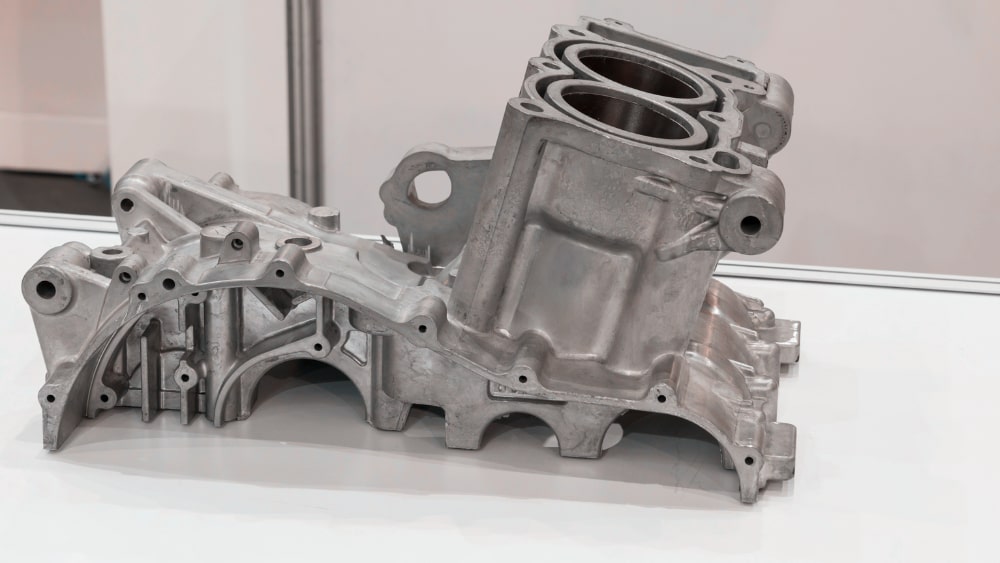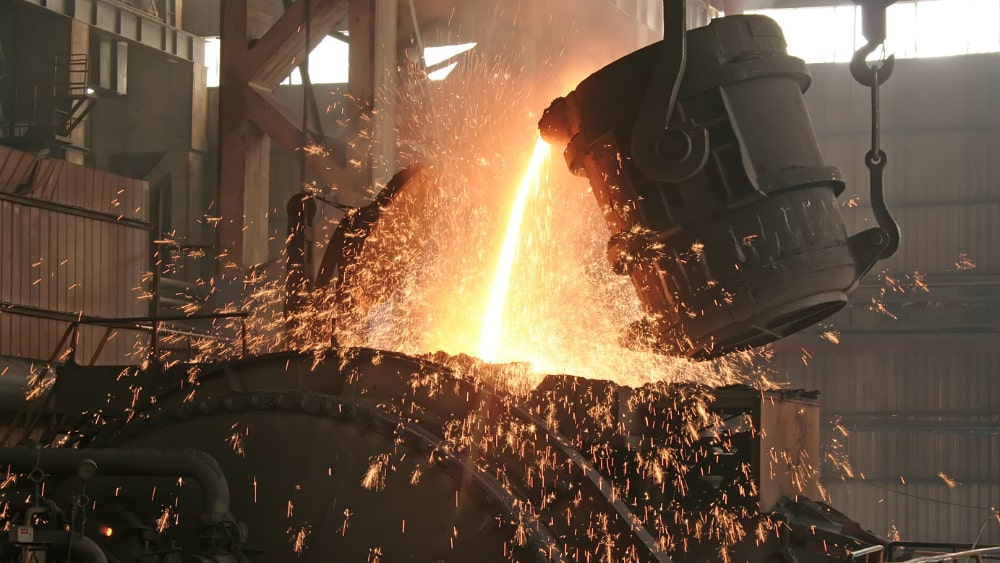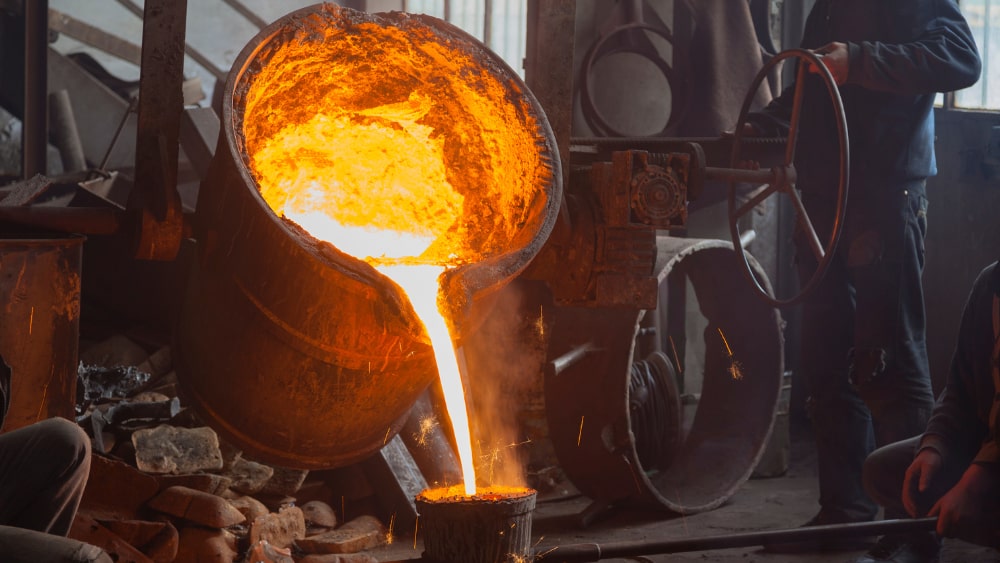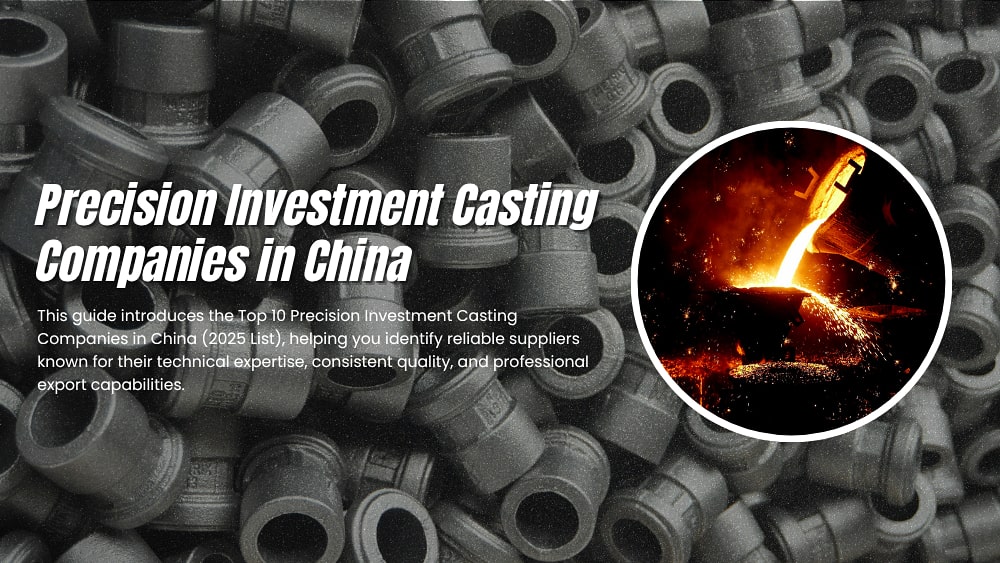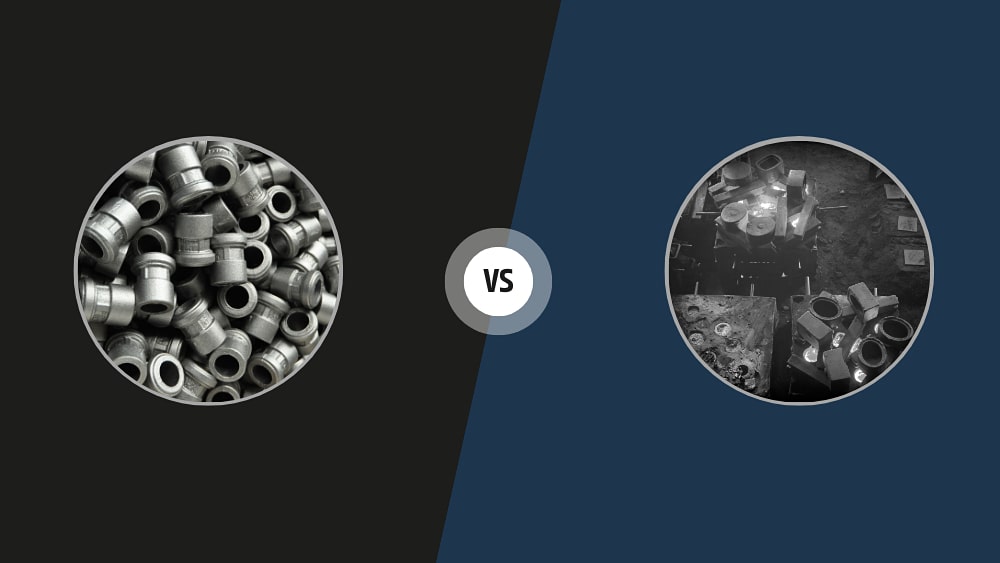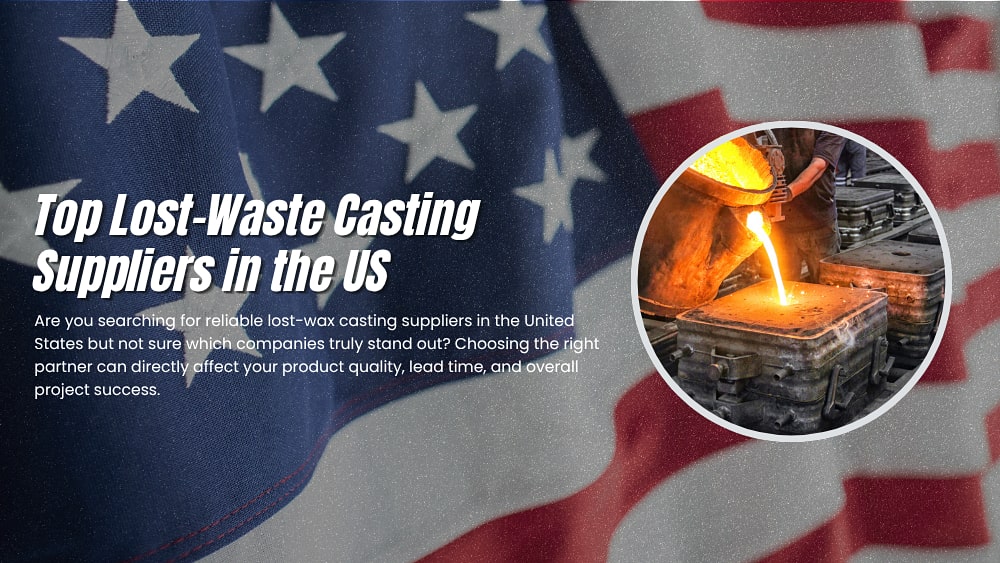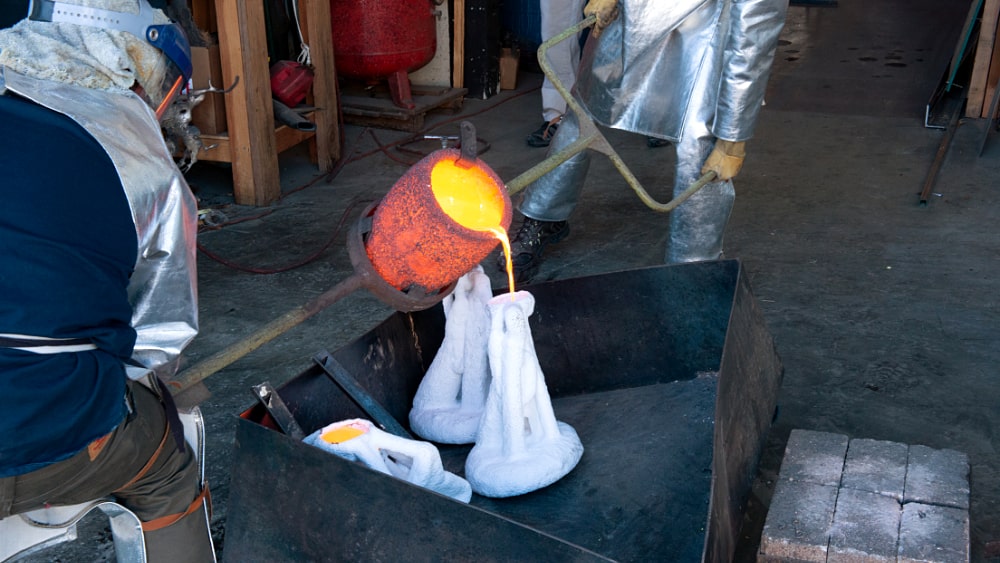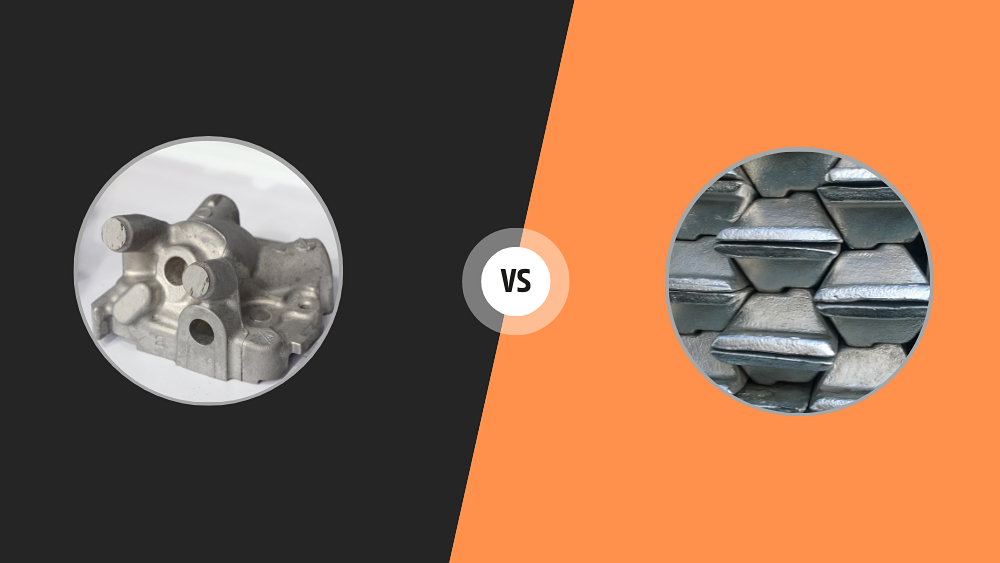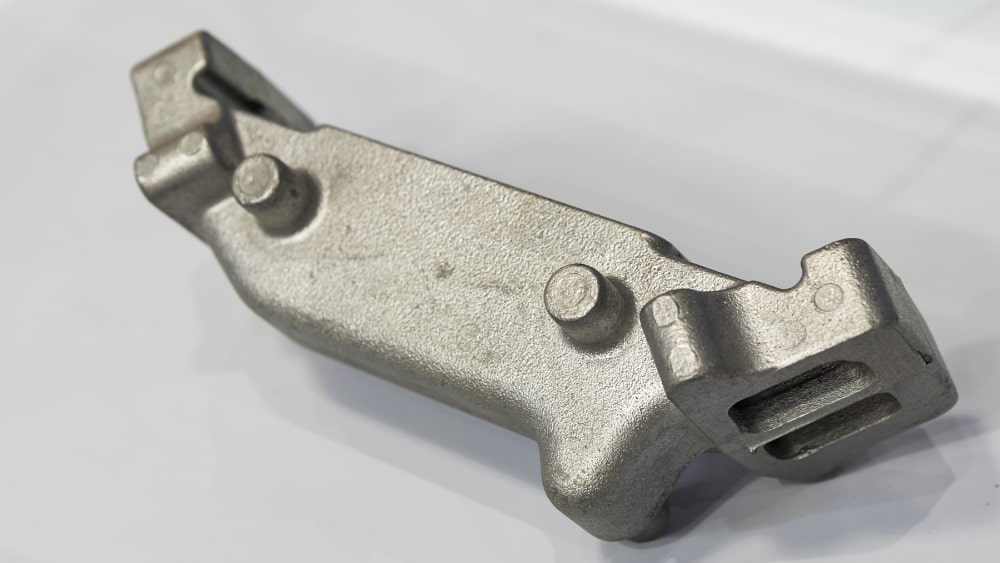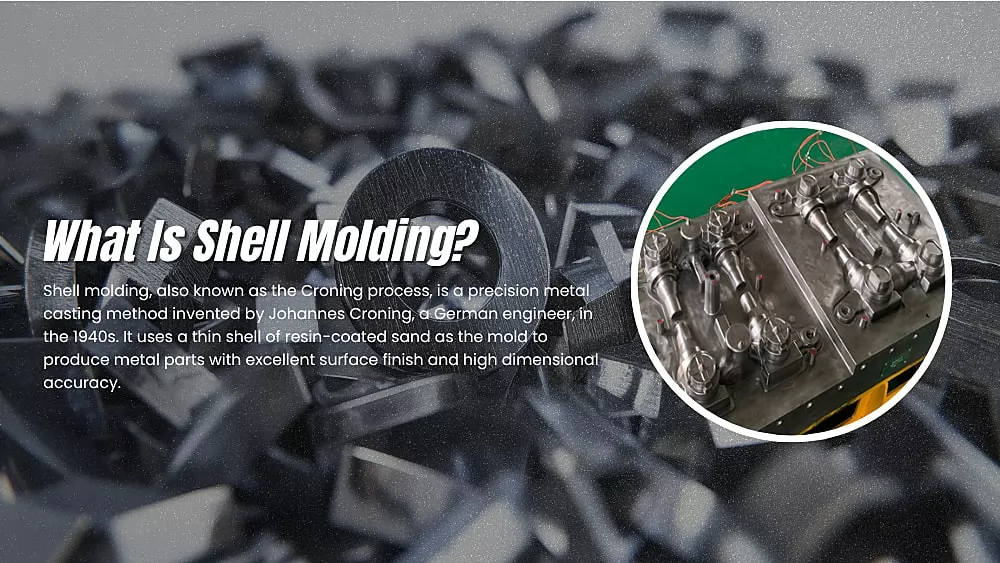
Shell molding is a special way of making metal parts that allows manufacturers to create shapes that are precise and detailed. Unlike simple sand casting, shell molding uses a thin layer of sand mixed with resin to form a strong mold. This process is often used for parts in cars, airplanes, and machines that need to fit together perfectly. In this article, we will explain what shell molding is, how the process works step by step, and what its main benefits and limitations are, helping beginners understand this important metal casting method.
What Is Shell Molding?
Shell molding, also known as the Croning process, is a precision metal casting method invented by Johannes Croning, a German engineer, in the 1940s. It uses a thin shell of resin-coated sand as the mold to produce metal parts with excellent surface finish and high dimensional accuracy.
In this process, a heated metal pattern is coated with a mixture of fine sand and thermosetting resin. The heat causes the resin to cure, forming a hard shell around the pattern. Two shell halves are then joined together to create the complete mold, into which molten metal is poured. After cooling, the shell is broken away to release the finished casting.
Shell molding is similar to traditional sand casting, but it delivers smoother surfaces, tighter tolerances, and greater repeatability. The reusable metal pattern enables higher production rates, while the disposable shell mold allows complex shapes to be produced efficiently.
This process is suitable for both ferrous and non-ferrous metals, such as cast iron, carbon steel, stainless steel, aluminum, and copper alloys. It is widely used for small to medium-sized precision components like gear housings, cylinder heads, crankshafts, connecting rods, and valve bodies — especially in the automotive, aerospace, and machinery industries.
In short, shell molding is valued for its accuracy, surface quality, and efficiency, making it one of the most reliable casting processes for complex and high-precision metal parts.
Shell Molding Process: How Is It Performed?
The shell molding process is a precision casting method that follows six main steps:
Step 1. Pattern Creation
A two-piece metal pattern is made from iron or steel, shaped exactly like the desired part. Aluminum or graphite can also be used for specific metals or low-volume production.
Step 2. Mold Formation
Each pattern half is heated to around 175–370°C (350–700°F) and coated with a lubricant. The heated pattern is then covered with a sand–resin mixture, which hardens into a thin shell around the pattern. Both halves are cured in an oven to complete the mold.
Step 3. Mold Assembly
The two shell halves are joined and clamped together. If the part requires cores, they are inserted before closing. The assembled mold is placed into a flask and supported with backing material.
Step 4. Pouring
Molten metal is poured into the mold cavity through a gating system. The metal fills the entire mold to form the shape.
Step 5. Cooling
The molten metal is allowed to cool and solidify inside the shell mold, taking on its final form.
Step 6. Casting Removal
Once cooled, the mold is broken open, and the solid casting is removed. Any excess metal or sand is cleaned off to reveal the finished part.
What Are the Main Advantages of Using Shell Casting?
Shell casting offers several key advantages that make it ideal for producing precise and high-quality metal parts:
-
Excellent Dimensional Accuracy
The resin-coated sand forms a strong, smooth mold surface, resulting in castings with tight tolerances and minimal machining needs. -
Superior Surface Finish
Parts produced by shell molding have a clean, fine surface — much smoother than traditional sand castings. -
High Production Efficiency
Reusable metal patterns and automated processes enable faster cycle times and consistent results, suitable for medium- to high-volume production. -
Capability for Complex Shapes
Thin-walled molds can reproduce intricate geometries and fine details that are difficult to achieve with other casting methods. -
Reduced Defects and Waste
Shell molds provide excellent permeability and thermal stability, minimizing porosity, sand inclusion, and deformation.
Overall, shell casting combines precision, speed, and efficiency — making it a preferred choice for automotive, aerospace, and machinery components.
What Are the Main Disadvantages of Shell Casting?
While shell casting offers many benefits, it also comes with some limitations that should be considered before choosing this process:
-
Higher Tooling and Pattern Cost
The process requires precision metal patterns and special equipment for heating and coating, which can increase initial setup costs. -
Limited to Small and Medium Parts
Shell molds are relatively thin and fragile, making them unsuitable for casting very large or heavy components. -
Not Ideal for Low-Volume Production
Due to the high cost of patterns and setup, shell casting is more economical for medium- to high-volume runs rather than small batches. -
Temperature Sensitivity
The resin-coated sand shells can lose strength at very high pouring temperatures, which limits the process for some superalloys. -
Post-Casting Cleaning Required
Although the surface finish is smooth, the casting still requires trimming, sand removal, and sometimes machining to achieve final precision.
Understanding both the advantages and disadvantages of shell casting helps manufacturers and engineers determine whether this process best fits their production needs and cost goals.
Applications of Shell Casting

Shell casting is widely used across multiple industries thanks to its precision, repeatability, and excellent surface finish. The process is ideal for producing small to medium-sized metal parts that require tight tolerances and complex geometries.
-
Automotive Industry
Shell casting is commonly used to manufacture critical automotive components such as camshafts, crankshafts, cylinder heads, connecting rods, bearing housings, and gear housings. These parts require precision and durability under high stress. -
Aerospace and Defense
Due to its ability to create complex, lightweight parts, shell casting is used for engine components, turbine blades, brackets, and housings that must meet strict performance and weight standards. -
Industrial Machinery
The process is suitable for pump bodies, valve housings, levers, impellers, and gear covers used in heavy machinery and manufacturing equipment where dimensional stability is crucial. -
Medical and Precision Equipment
Shell molding can produce stainless steel components, surgical tools, and precision fittings that demand smooth surfaces and high accuracy for safety and performance. -
Marine and Energy Sectors
It is also applied in producing propellers, engine brackets, and heat-resistant components for marine, oil, and energy systems where corrosion resistance and strength are essential.
With its ability to deliver high-quality, intricate castings, shell molding remains a preferred choice for manufacturers seeking reliable and efficient production of complex metal components.
What Are the Metals Used in Shell Molding?
Shell molding is compatible with a wide range of ferrous and non-ferrous metals, making it a versatile choice for various industrial applications. The table below summarizes the most commonly used materials, their properties, and typical applications to help users select the best option for their casting needs.
| Metal Type | Main Characteristics | Common Grades / Alloys | Advantages | Typical Applications |
|---|---|---|---|---|
| Carbon Steel | Iron alloy with low alloying content (under 10.5%). Excellent hardness and wear resistance. | C20, C25, C30, C45 | High machinability, strong, recyclable, ferromagnetic. | Gears, shafts, brackets, industrial machinery parts. |
| Stainless Steel | Steel with ≥10.5% chromium. High corrosion and oxidation resistance. | Austenitic, Ferritic, Martensitic, Duplex, PH stainless steels | Excellent durability, corrosion resistance, good for high-temperature applications. | Pumps, valves, medical tools, marine and food equipment. |
| Aluminum Alloys | Lightweight, corrosion-resistant metals with good casting performance. | ASTM A356, ASTM A413, ASTM 360 | Low density, high conductivity, good surface finish, easy to machine. | Automotive components, housings, electronic covers. |
| Alloy Steel | Steel combined with alloying elements for improved strength and wear resistance. | 20Mn, 45Mn, 42CrMo, 20CrNiMo, 16CrMo4, 9Mn2V | High strength, good hardenability, heat and wear resistance. | Axles, crankshafts, connecting rods, mechanical tools. |
| Copper & Copper Alloys | Ductile and conductive non-ferrous metals suitable for shell casting (except brass). | Pure Copper, Bronze, Cu-Ni alloys | Excellent conductivity, corrosion resistance, ductility. | Electrical components, bearings, marine fittings. |
| Low Alloy Steel | Steel with less than 8% alloying elements; similar to carbon steel but more hardenable. | 10CrMo9-10, 34CrMo4, 40Cr, 15CrMo | Economical, strong, good machinability, versatile. | General machinery, automotive, and structural components. |
When choosing the right metal for shell molding, consider factors such as mechanical strength, corrosion resistance, machinability, cost, and application environment. For example, stainless steel is ideal for high-corrosion conditions, while carbon and low-alloy steels are better suited for cost-sensitive, general-purpose parts. Aluminum and copper alloys are preferred for lightweight or high-conductivity applications.
By understanding each metal’s characteristics and compatibility with the shell molding process, engineers and buyers can make more informed material selections to achieve the desired performance and cost balance.
Comparison of Shell Casting with Other Casting Processes
Shell casting can be compared to other common metal casting methods based on precision, surface finish, production volume, cost, and suitable applications. The table below summarizes the main differences:
| Casting Method | Main Characteristics | Advantages | Limitations | Typical Applications |
|---|---|---|---|---|
| Shell Casting | Thin resin-coated sand shell; reusable metal pattern; medium to high precision. | Good surface finish, tight tolerances, suitable for complex geometries, versatile metal choices. | Higher tooling cost than sand casting; limited for very large parts. | Automotive parts, gear housings, cylinder heads, industrial machinery. |
| Sand Casting | Loose sand mold; inexpensive; suitable for large parts. | Low cost, flexible for large components, easy to use. | Lower dimensional accuracy, rougher surface finish, more post-machining required. | Engine blocks, pump housings, structural components. |
| Investment Casting | Wax pattern and ceramic shell; extremely detailed and precise. | Ultra-high accuracy, excellent surface finish, ideal for intricate shapes. | Higher cost, slower production, more labor-intensive. | Medical implants, aerospace components, small precision parts. |
| Die Casting | Permanent metal mold; mostly non-ferrous metals; high-volume production. | Very fast production, excellent surface finish, low unit cost at scale. | High die cost, limited to small/medium parts, less flexible for complex shapes. | Automotive parts, electronics housings, consumer products. |
By comparing shell casting with other methods, manufacturers can select the best process based on part complexity, production volume, precision requirements, and cost constraints.
When Is Shell Casting Used to Produce Metal Parts?
Shell casting is chosen when high precision, smooth surface finish, and complex geometries are required in metal components. It is particularly suitable for:
-
Medium-sized parts – Shell molding is ideal for parts that are too small for sand casting to achieve the required tolerances but too large or costly for investment casting.
-
Complex shapes – The thin-walled resin-coated shell allows the production of intricate designs and fine details that other methods may struggle to reproduce.
-
High-volume production – Reusable metal patterns and automated shell-making processes make it efficient for producing multiple identical parts with consistent quality.
-
Diverse metal types – Both ferrous (carbon steel, alloy steel, stainless steel) and non-ferrous metals (aluminum, copper alloys) can be cast.
-
Industries requiring precision – Automotive, aerospace, medical, and industrial machinery components often rely on shell casting for gear housings, cylinder heads, camshafts, connecting rods, and valve bodies.
In short, shell casting is used whenever accuracy, efficiency, and high-quality surface finish are more important than low initial tooling costs.
What Is the Cost of Shell Casting?
The cost of shell casting depends on factors such as pattern creation, mold materials, part complexity, and production volume. Initial tooling and metal patterns increase upfront costs, but for medium-to-high volume production, the per-part cost becomes economical due to reusable patterns and efficient mold preparation. Typical shell castings for small parts (under 1 kg) may range from $50 to $150 per piece, medium parts (1–5 kg) around $150 to $300 per piece, and larger parts (5–20 kg) can range from $300 to $500 per piece. Extremely complex or precision-critical components may exceed $500 per piece. While shell casting is more expensive than simple sand casting, it provides higher dimensional accuracy, smoother surface finish, and the ability to produce complex geometries, making it a cost-effective choice for automotive, aerospace, and industrial applications.
What Should You Consider When Using Shell Molding?
When using shell molding, the most important factors to consider are part complexity and production volume. This process works best for small to medium parts with intricate shapes, and it becomes cost-effective when producing multiple identical components due to the reusable metal patterns. Proper material selection is also crucial, as different metals affect mold behavior, surface finish, and final tolerances.
Frequently Asked Questions about Shell Molding
The following frequently asked questions provide a quick overview to help users understand the process, its advantages, and practical applications.
How long do shell mold castings last?
Shell mold castings are durable and can withstand normal wear and stress in industrial applications. Their lifespan depends on the metal used, design, and operating conditions.
What is the quality of shell mold castings?
Shell molding produces castings with excellent dimensional accuracy, smooth surface finish, and consistent quality, making it suitable for precision parts in automotive, aerospace, and industrial machinery.
Are shell mold castings durable?
Yes, shell mold castings are strong and reliable. They perform well under mechanical stress, especially when made from alloy or stainless steel, and can be used in demanding environments.
Why choose shell molding over other casting methods?
Shell molding offers a balance of precision, surface finish, and cost-efficiency for medium- to high-volume production. It is ideal for complex geometries that are difficult to achieve with sand casting or die casting.
Which metals can be used in shell molding?
Both ferrous (carbon steel, alloy steel, stainless steel) and non-ferrous metals (aluminum alloys, copper alloys) are suitable for shell molding, depending on the application requirements.
Trust Qianhao to provide high-quality shell molding solutions tailored to your metal casting needs.
Trust Qianhao to Meet Your Shell Mold Casting Needs
When your success depends on the quality and reliability of your castings, trust is paramount. Qianhao is your dedicated partner in high-quality shell molding, delivering components that meet the strictest standards for industries like automotive, machinery, and hydraulics. Contact our team today for a quote or to discuss your specific project needs.


